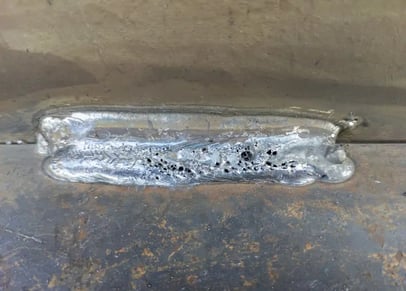What is Porosity in Welding: Common Resources and Efficient Remedies
What is Porosity in Welding: Common Resources and Efficient Remedies
Blog Article
Deciphering the Enigma of Porosity in Welding: Tips for Reducing Problems and Maximizing Quality
In the elaborate world of welding, porosity stays a relentless challenge that can considerably influence the quality and integrity of welded joints. As we delve into the depths of porosity in welding, discovering the tricks to its avoidance and control will be vital for experts seeking to master the art of top quality weldments.
Comprehending Porosity in Welding
Porosity in welding, a common concern encountered by welders, refers to the presence of gas pockets or gaps in the welded product, which can compromise the integrity and high quality of the weld. These gas pockets are commonly caught throughout the welding process due to various variables such as incorrect protecting gas, contaminated base materials, or incorrect welding parameters. The development of porosity can damage the weld, making it prone to fracturing and deterioration, ultimately causing structural failings.
Recognizing the origin of porosity is essential for welders to effectively avoid its incident. By recognizing the relevance of keeping correct gas protecting, making sure the tidiness of base products, and optimizing welding setups, welders can substantially decrease the possibility of porosity development. Furthermore, making use of strategies like preheating the base product, utilizing correct welding techniques, and performing comprehensive inspections post-welding can better assist in reducing porosity issues. In general, a comprehensive understanding of porosity in welding is necessary for welders to create top quality and sturdy welds.

Usual Reasons of Porosity
When evaluating welding processes for possible quality issues, understanding the typical reasons of porosity is crucial for maintaining weld stability and preventing structural failings. Porosity, defined by the visibility of dental caries or gaps in the weld metal, can substantially endanger the mechanical homes of a bonded joint.
Furthermore, welding at incorrect criteria, such as exceedingly high traveling speeds or currents, can create too much disturbance in the weld swimming pool, trapping gases and causing porosity. By dealing with these common reasons via appropriate gas protecting, material prep work, and adherence to ideal welding specifications, welders can reduce porosity and boost the top quality of their welds.
Methods for Porosity Prevention
Implementing reliable safety nets is important in reducing the event of porosity in welding procedures. One technique for porosity avoidance is making sure proper cleansing of the base steel prior to welding. Pollutants such as oil, oil, rust, and paint can bring about porosity, so detailed cleaning using proper solvents or mechanical methods is vital.

One more key safety net is the selection of the ideal welding consumables. Using high-grade filler products and protecting gases that are suitable for the base metal click for more info and welding procedure can considerably lower the danger of porosity. In addition, maintaining proper welding criteria, such as voltage, current, take a trip rate, and gas flow rate, is essential for porosity prevention. Differing the suggested setups can result in improper gas insurance coverage and inadequate combination, causing porosity.
Additionally, employing proper welding methods, such as preserving a constant traveling speed, electrode angle, and arc length, can assist stop porosity (What is Porosity). Ample training of welders to ensure they follow best techniques and quality assurance procedures is likewise essential in reducing porosity problems in check that welding

Ideal Practices for Top Quality Welds
Making sure adherence to industry criteria and appropriate weld joint preparation are fundamental facets of attaining constantly top notch welds. Along with these foundational steps, there are several ideal methods that welders can execute to further boost the high quality of their welds. One secret method is maintaining correct tidiness in the welding area. Impurities such as oil, grease, corrosion, and paint can negatively affect the top quality of the weld, bring about flaws. Completely cleansing the workpiece and bordering area prior to welding can assist mitigate these concerns.
Another best practice is to carefully select the appropriate welding parameters for the specific materials being signed up with. Correct specification choice guarantees optimal weld penetration, fusion, and general high quality. Using top quality welding consumables, such as electrodes and filler metals, can dramatically influence the final weld quality.
Importance of Porosity Control
Porosity control plays an essential role in ensuring the honesty and high quality of welding joints. Porosity, characterized by the visibility of tooth cavities or voids within the weld steel, can substantially jeopardize the mechanical buildings and structural integrity of the weld. Extreme porosity compromises the weld, making it extra prone to breaking, deterioration, and general failing under operational lots.
Reliable porosity control is essential for keeping the desired mechanical properties, such as stamina, ductility, and toughness, of the welded joint. What is Porosity. By lessening porosity, welders can boost the overall high quality and dependability of the weld, making certain that it meets the performance demands of the desired application
Furthermore, porosity control is vital for accomplishing the preferred visual look of the weld. Too much porosity not just deteriorates the weld yet also detracts from its visual appeal, which can be vital in markets where aesthetics are very important. Appropriate porosity control techniques, such as using the appropriate protecting gas, managing the welding specifications, and making sure appropriate tidiness her comment is here of the base materials, are important for producing top quality welds with marginal flaws.

Conclusion
In final thought, porosity in welding is a common flaw that can compromise the top quality of the weld. It is important to regulate porosity in welding to ensure the honesty and strength of the last item.
Report this page